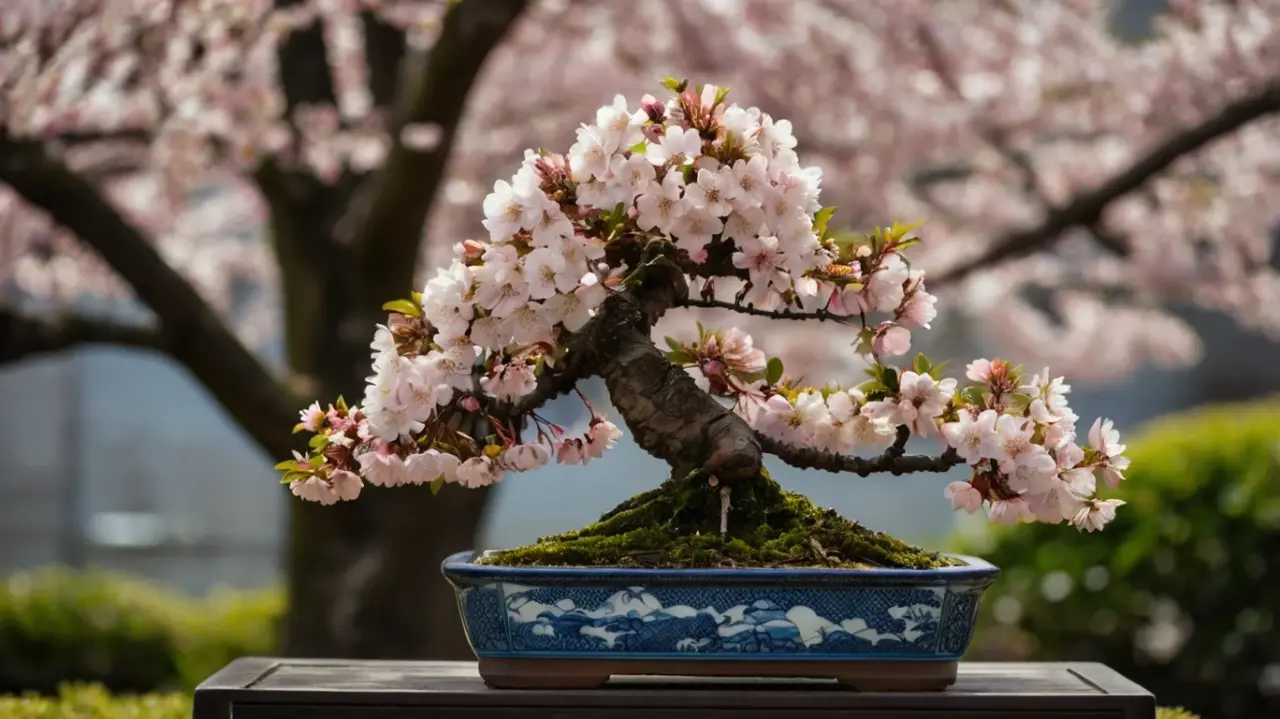
Introduction
With over a decade of dedicated bonsai cultivation, numerous awards in the art of bonsai shaping, and a profound certification in horticulture, I bring to you a treasure of knowledge in nurturing these miniature marvels. Cherry Blossom Bonsai, known as Sakura Bonsai in Japan, embodies a timeless elegance that captivates hearts and adorns spaces with its enchanting blooms. This guide is your key to not only witnessing but also ensuring the spectacular display of their delicate pink blossoms, year after year.
Understanding Your Cherry Blossom Bonsai
Species Spotlight
Among the plethora of enchanting varieties, two stand out for their unmatched beauty and grace in the cherry bonsai realm—the Sargent’s Weeping Cherry (Prunus sargentii) and the Higan Cherry (Prunus subhirtella). The Sargent’s Weeping Cherry boasts a captivating display with its dramatic, cascading branches adorned with deep pink blossoms, creating a mesmerizing effect that seems almost surreal. This variety thrives in the spotlight, requiring ample sunlight to showcase its full glory. On the other hand, the Higan Cherry, with its ethereal, pale pink flowers, offers a more subtle charm. This resilient variety is known for its adaptability, flourishing in both sunny and partially shaded conditions, making it a versatile choice for bonsai enthusiasts.
While both varieties herald spring with their vibrant blooms, their growth patterns and care requirements offer a diverse exploration of bonsai cultivation. The weeping nature of the Sargent’s Cherry requires meticulous pruning to maintain its shape and encourage the cascading effect of its branches, whereas the more upright growth of the Higan Cherry provides a different aesthetic and care approach, focusing on vertical structure and canopy shaping.
Unvealing Bonsai Needs
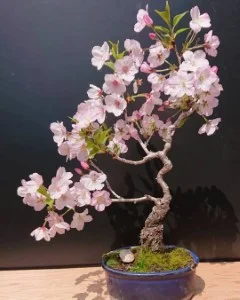
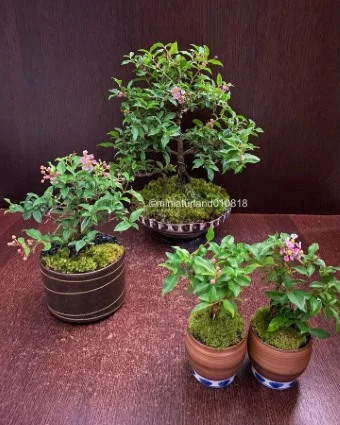

To ensure your Cherry Blossom Bonsai thrives, illuminating its space with abundant blooms, understanding its basic needs is paramount. Sunlight acts as the catalyst for flowering; thus, positioning your bonsai in a location where it can bask in the sun for at least six hours daily is crucial. However, too much direct sunlight, especially during the peak summer months, can be detrimental, making a balance between sun and partial shade ideal for these delicate trees.
Temperature:
Temperature also plays a vital role in the growth cycle of a cherry bonsai. They prefer a temperate climate, with a dormant period in the winter essential for flower bud development. Spring and early autumn offer the most favorable conditions, with protection from extreme temperatures in summer and winter crucial for their survival.
Watering:
Watering your cherry bonsai demands a careful balance—sufficient to keep the soil moist, but not so much that it leads to waterlogging, which could cause root rot. The frequency of watering will vary with the seasons, requiring more vigilance during warmer months and less so during cooler periods.
Humidity:
Humidity is the final piece of the puzzle, particularly for indoor bonsais. Cherry Blossom Bonsais appreciate a humid environment, which can be achieved by placing a humidity tray filled with water beneath the pot, ensuring that the roots do not sit directly in water. This simulates the moist air conditions of their natural habitat, promoting healthy growth and vibrant blooms.
By understanding these intricate needs and characteristics of various cherry bonsai varieties, enthusiasts can cultivate these magnificent miniature trees, ensuring their beauty is maximized for years to come.
Cultivating Your Miniature Masterpiece
The Perfect Spot: Navigating Light and Location
Finding the ideal spot for your Cherry Blossom Bonsai is crucial for its growth and blooming. These exquisite miniatures yearn for bright, but not scorching, rays of sunshine. A location that invites morning sunlight while providing shelter from the harsh afternoon sun is optimal. This balanced exposure ensures vibrant blooms without the risk of leaf scorch.
Seasonal adjustments are key; as the intensity of the sun shifts, so should the positioning of your bonsai. During the warmer months, consider moving your bonsai to a spot with more shade to protect it from intense heat. Conversely, in the colder months, a sunnier spot can compensate for the weaker, less frequent sunlight, especially if you’re cultivating your bonsai indoors.
The Art of Watering: Striking the Right Balance
Watering your Cherry Blossom Bonsai is less about a strict schedule and more about observing and responding to its needs. The goal is to maintain moist, but not waterlogged, soil. Factors like pot size, soil type, and the current climate play pivotal roles in this delicate balance. A well-draining bonsai soil mix helps prevent over-watering issues, such as root rot.
Feel the soil daily; if the top layer feels dry, it’s time to water. Employ a soft, rain-like watering technique until excess water drains from the bottom. This method ensures even soil moisture, essential for healthy root development.
To maintain the necessary humidity levels, misting your bonsai regularly and using a humidity tray can be effective, especially during dry seasons. Ensure the bonsai pot sits above the water level in the tray to avoid direct contact, emulating a moisture-rich environment.
Soil Secrets: The Foundation of Flourishing Bonsai
The significance of a well-draining soil mix cannot be overstated. It supports proper root health by allowing excess water to escape, preventing root diseases. For Cherry Blossom Bonsai, a mix comprising one part lava rock, one part akadama, and one part pumice offers an ideal structure. This combination facilitates adequate water retention and aeration, crucial for root growth.
There are pre-mixed bonsai soils available for those seeking convenience. However, creating your mix allows you to adjust components based on your bonsai’s specific needs and your local climate.
Nourishing Your Bonsai: The Fertilizer Factor
During the growing season, your Cherry Blossom Bonsai craves nutrients to support its spectacular bloom. A balanced, slow-release fertilizer, applied every four to six weeks, can meet this demand. Look for a fertilizer with an even NPK ratio (nitrogen, phosphorus, potassium) to encourage both foliar and root development.
Beware of over-fertilization; more isn’t always better. Too much fertilizer can lead to salt buildup in the soil, potentially harming your bonsai. Observing your bonsai’s response to feeding and adjusting accordingly will keep it in peak condition, showcasing those breathtaking blooms that make all your efforts worthwhile.
Unlocking Breathtaking Blooms


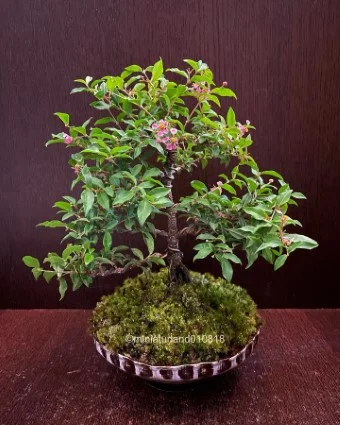
The Magic of Pruning: Shaping Beauty and Encouraging Blooms
To cultivate the ethereal beauty of your Cherry Blossom Bonsai, mastering the art of pruning is essential. Pruning does more than just maintain the diminutive stature of your bonsai; it’s a delicate dance with nature that encourages vigorous growth and magnificent flowering. The ideal time to wield your pruning shears is shortly after the blossoms fade, a period when the tree is less vulnerable, allowing for recovery and growth.
Selective pruning focuses on removing any dead or overgrown branches, thus not only preserving the tree’s form but also enhancing its overall health. Strategic cuts stimulate the development of new, floriferous branches, setting the stage for a spectacular display in the following season. Remember, each cut is a guiding hand, directing growth and refining the bonsai’s aesthetic, so it’s crucial to choose your cuts wisely, always with the tree’s future beauty in mind.
Winter Wonderland: Ensuring a Season of Rest
Winter dormancy is a period of rest that is as crucial as any growing season for your Cherry Blossom Bonsai. This phase is essential for the tree to conserve energy for the spectacular bloom that awaits in spring. To ensure your bonsai navigates this period successfully, a cooler environment is key — ideally, temperatures ranging from 5°C to 10°C (41°F to 50°F). This mimics the natural chilling period that triggers the developmental processes leading to bud formation.
Adjusting your watering routine is also essential during these cooler months. The bonsai’s metabolic activities slow down, necessitating less frequent watering. However, the soil should never be allowed to completely dry out, as maintaining a degree of moisture is crucial for the tree’s health. Protecting your bonsai from frost is paramount — consider relocating it to a sheltered outdoor area or an unheated indoor space like a garage, where it can rest without the risk of freezing.
By understanding and nurturing the unique needs of your Cherry Blossom Bonsai through each season, you coax out its inner splendor, ensuring that it graces your space with its breathtaking blooms year after year.
Troubleshooting Common Bonsai Ailments
Diagnosis and Solutions: Navigating Cherry Blossom Bonsai Challenges
Even the most cared-for Cherry Blossom Bonsai can encounter its share of troubles, from leaf discoloration to unwelcome pests and diseases. Understanding these issues and knowing how to address them is crucial for maintaining your bonsai’s health and beauty.
Leaf Discoloration: Unmasking the Cause
Leaf discoloration in Cherry Blossom Bonsai can often be attributed to either nutritional deficiencies or overexposure to sunlight. Yellowing leaves may indicate a lack of essential nutrients—usually nitrogen. To counteract this, ensure your fertilization routine is consistent and uses a balanced product. If leaves appear scorched or brown, this could be a sign of too much direct sunlight. Modifying your bonsai’s placement to a location with dappled light can mitigate this issue while still providing the necessary energy for growth.
Pest Invasion: The Usual Suspects
Spider mites and aphids are common adversaries of Cherry Blossom Bonsai. These tiny pests sap the vitality of the plant, often resulting in weakened foliage and stunted growth. Regular inspection of your bonsai is key; keep an eye out for fine webs or clusters of small bugs. A gentle but thorough washing with insecticidal soap or neem oil can help control these pests. Additionally, introducing natural predators like ladybugs into your garden can offer a long-term, ecological solution.
Fighting Off Diseases: A Clean Bill of Health
Fungal diseases, such as powdery mildew, present a significant threat to the Cherry Blossom Bonsai, coating leaves with a distinctive white powder and compromising their health. Ensuring good air circulation around your bonsai is a preventive measure that shouldn’t be overlooked. If infection occurs, remove affected areas immediately and treat the plant with a fungicidal spray designed for bonsai use. Maintaining cleanliness in the area around your bonsai, such as removing fallen leaves, can also reduce the risk of fungal issues.
Prevention is Better Than Cure
The best strategy against these common issues is a proactive approach. Maintaining a consistent care routine, adapting to seasonal changes, and being vigilant about the early signs of trouble can save you from more significant problems down the line. Regularly cleaning your tools and inspecting new plants before introduction to your garden are simple practices that can have a significant impact on the health of your Cherry Blossom Bonsai.
By staying informed and attentive, you can ensure that your Cherry Blossom Bonsai remains a vibrant and flourishing centerpiece in your collection, captivating all who gaze upon it with its enduring beauty.
Beyond the Basics: Achieving Bonsai Mastery
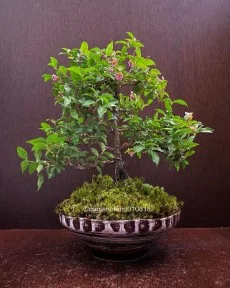
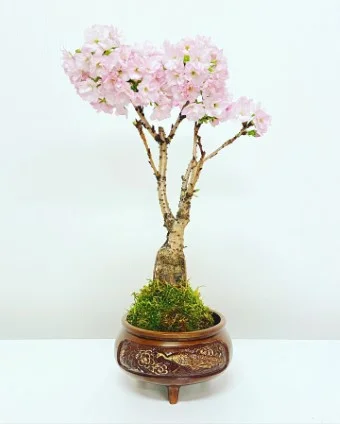

Wiring Techniques: Sculpting with Precision
Bonsai wiring is an art form in itself, a methodical technique that allows for precise directional guidance of your Cherry Blossom Bonsai’s branches. This practice is not just about aesthetics; it’s about embodying the essence of nature in miniature. Wiring should be approached with patience and care, typically using annealed copper or aluminum wire. Begin by selecting branches you wish to shape, wrapping the wire snugly but not too tightly, to avoid damaging the bark. Gently bend the branches to your desired angle or direction, keeping in mind the natural flow. The duration the wire remains on the plant varies, but it is crucial to monitor growth closely and remove the wire before it can cut into the expanding branches. Guided correctly, wiring can transform your bonsai, contributing to its elegance and harmony.
Repotting: Laying the Foundation for Growth
Repotting is a vital aspect of Cherry Blossom Bonsai care, necessary for maintaining root health and ensuring your tree continues to thrive in its miniature environment. Ideally conducted in early spring before the new growth starts, repotting provides the opportunity to refresh the soil, trim the roots, and adjust the pot size if necessary. Select a pot that complements your bonsai’s size and shape — it should be large enough to accommodate growth for the next two to three years. Carefully remove your bonsai from its current pot, gently teasing out the roots and removing about one-third of the root mass. This pruning encourages healthier, more fibrous roots to form, which are better for nutrient uptake. After placing your bonsai in its new pot, be sure to use well-draining soil specific to bonsai to give your plant the best chance for success. Repotting can be a shock to your bonsai, so providing a stable, sheltered environment afterwards is key for recovery. Through repotting, your Cherry Blossom Bonsai gains the fresh foundation it needs for vibrant health and blooms.
Conclusion
Recap & Rewards:
Throughout this guide, we’ve unraveled the mysteries and joys of Cherry Blossom Bonsai care, spotlighting the essential practices that ensure its prosperity. Key takeaways include the importance of diagnosing and addressing leaf discoloration and pests swiftly, the art and precision behind wiring techniques, and the rejuvenating effects of timely repotting. All these efforts converge to a singular goal: a healthy, flourishing bonsai that mirrors the serene beauty of nature in miniature.
Enduring Beauty:
The enduring appeal of a Cherry Blossom Bonsai extends far beyond its seasonal blooms. These miniature marvels can live for decades, even centuries, with each passing year adding layers of depth and character to their appearance. The satisfaction derived from nurturing these living sculptures, guiding their growth and witnessing their seasonal transformations, is unmatched. Cultivating a Cherry Blossom Bonsai is not merely a hobby; it’s an enriching journey through the cycles of life, marked by patience, learning, and immense gratification.
Call to Action:
We invite you to share your bonsai journeys in the comments below. Whether you’re a seasoned bonsai gardener or just starting, your experiences and questions enrich our collective knowledge and passion for these extraordinary plants. Together, we can cultivate not just bonsais, but a community bound by the shared love for these symbols of enduring beauty and resilience.